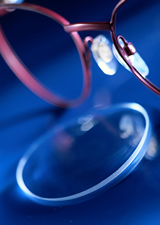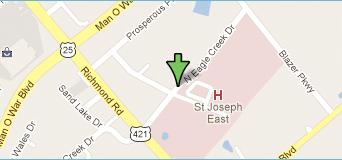Glasses & Contacts
 Over 140 million people in the U.S. wear eyeglasses, and over 30 million wear contact lenses. Glasses and contact lenses improve vision by adjusting the way the eyes bend and focus light. Ideally, light rays are refracted (bent) as they pass through the cornea so that they focus on the retina in the back of the eye. In a healthy eye, this means that objects can be seen clearly. However, many people’s corneas have a shallow or steep curvature which causes light rays to focus in front of or behind the retina. Objects may then appear blurry at certain distances or at all distances.
Over 140 million people in the U.S. wear eyeglasses, and over 30 million wear contact lenses. Glasses and contact lenses improve vision by adjusting the way the eyes bend and focus light. Ideally, light rays are refracted (bent) as they pass through the cornea so that they focus on the retina in the back of the eye. In a healthy eye, this means that objects can be seen clearly. However, many people’s corneas have a shallow or steep curvature which causes light rays to focus in front of or behind the retina. Objects may then appear blurry at certain distances or at all distances.
Glasses and contact lenses correct these refractive errors. Prescriptions are measured for each eye so patients can enjoy optimal vision clarity, usually 20/20. Eyewear may be used for certain activities, such as reading for farsighted (hyperopic) patients and driving or watching television for nearsighted (myopic) patients, or may be worn at all times.
Regular eye exams test for the development and progression of refractive errors and help your optometrist provide a proper prescription if eyeglasses or contact lenses are needed. Exams are also an invaluable tool in the early detection of eye disease.
Contact Lens Fittings and Supplies (including specialty fits)
A contact lens is a thin disk which floats on the surface of the eye, providing vision correction.With advances in optical technology, almost everyone now can wear contact lenses, regardless of the type or extent of their vision problems. This includes patients with astigmatism and those who need bifocal or multifocal lenses. Our practice offers a comprehensive array of contact lenses to suit our patients’ individual needs – from daily disposables or extended-wear soft contacts to rigid gas-permeable lenses. We can help you find out which contact lenses are best for you. There are two classifications of contact lenses – soft and rigid gas permeable lenses. All contact lenses require a prescription.
Soft Contact Lenses
Gas-permeable Lenses
Rigid, gas-permeable contacts offer several benefits over soft lenses. They:
Because they are much harder than flexible contacts, gas-permeable lenses may take some getting used to when you first start wearing them. They are also more likely than soft lenses to slip off the center of your eye and require adjustment, making them an inconvenient choice for patients who play sports or participate in other demanding activities. However, most patients soon grow accustomed to the feel of gas-permeable lenses and are satisfied with the improvement in vision they offer without the need for glasses.

